Search Results for Tag: Warming
UN Climate Chief on New York summit
Your Ice Blogger has been busy with the New York climate summit around the corner. I was delighted to read that Ban Ki Moon is considering a special Arctic summit and a trip on a Greenpeace Arctic mission vessel after receiving a petition to Save the Arctic. I am also hoping there will be some high-profile promises of climate action.
Meanwhile, here in Bonn, I talked to Christiana Figueres, the Executive Secretary of the UNFCCC (Climate Secretariat), which is based here in Bonn, just next door to my Deutsche Welle Office, before she left for New York.
She told me what she expects of this meeting, which is something different from the regular UN climate summits. She also told me why she was joining yesterday’s climate march.
Let me share some excerpts from the interview in writing here with you, and offer you a full length audio version of my talk to this very influential and passionate lady.
More on the climate summit and the Arctic here soon.
Excerpts from my interview with Christiana Figueres:
Ice Blogger: Why do we need yet another climate summit?
The conferences we organize once a year have the purpose of moving towards a legally based agreement, scheduled to be adopted in Paris next year. In New York, nothing is going to be negotiated. It’s very much an attempt to blow wind into the sails of the formal process. It’s about raising political will and public awareness. It is a powerful opportunity for the leaders of countries and corporations to come forward and say what each of them is going to do.
UN Secretary-General Ban Ki-moon has asked these leaders to bring bold announcements and actions to the summit. What do you expect to come out of it?
We will have a host of announcements from governments about what they are already doing and will undertake with respect to bringing down their own emissions and increasing the resilience that they need to incorporate into their planning and their infrastructure to deal with the variability and the vulnerability of climate change. From the private sector we expect the same: announcements as to how they are going to contribute to reduce emissions, either in their own operations or, even more interestingly, how they are going to be shifting their capital into low-carbon services and products to accelerate the global shift towards a low-carbon economy.
Are you expecting major announcements by the host country USA or a key player such as China?
Yes, we are expecting all countries to come forward and begin to put on the table what they will be able to contribute next year into a much more formal setting. But for that, the deadline is not until March 2015. What we expect is indications of what is possible. The fact is that most countries around the world are currently doing their homework and figuring out at a national scale what is financially, politically, economically and technically possible for them to do.
The summit is taking place in the USA, a key player in terms of emissions and a possible new climate agreement. Can hosting the summit there make a difference to US attitudes and policy?
The second term of President Obama has seen an accelerated and up-scaled engagement on climate change. The latest move of the Obama administration to ask the EPA (US Environmental Protection Agency) to come forward with regulations on power plants is probably the most ambitious action the US government has taken on climate change. We expect President Obama will be giving indications of how the United States is going to further build on those efforts. It is also very interesting that on US land, there will be the people’s climate march, just two days before the summit. That will show that there is, even in the United States, broad and deep public support for global climate policy making.
Do you think this kind of grassroots movement is what we need to take things forward?
I think it’s a very important component. I’m very grateful to the organizers of the march and to everyone who’s going to be at the march. I will be there, because it’s important to give a very strong message that it is not just the responsibility of governments or corporations, but rather there is also civil society responsibility here to make their awareness and concern felt, and encourage countries and companies to move towards low-carbon economies as soon as possible.
Some people say cities and regions should play a bigger role while governments struggle to negotiate a climate agreement?
Well it’s not an either or. Cities all around the world have already taken a very impressive lead. And we will hear from them. The mayors of hundreds of cities will be in New York, and the same goes for regions, whether it’s groups of countries or groups of municipalities. The optimization of climate action is going to come from the coherent integration of policy from the international level to the national to the local level.
Isn’t it difficult to arouse interest in an additional climate summit in the current world political situation with attention focused on conflicts in the Middle East, Ukraine and other places?
The whole week in New York will see much press attention to the summit. Not only because we will have hundreds of thousands of people on the street, not only because we will have hundreds of political leaders there, hundreds of corporations, but because they are all coming to New York for one very powerful reason. That is, climate change is now the biggest challenge that humanity has faced, certainly in this century. And there is growing awareness of this. There is already a lot of conflict around the world, around water scarcity, around migration, around food and security, and that is exacerbated by climate change. So if we want to prevent conflicts that will scale out of control, then we have to address climate change in a timely fashion.
The latest figures show greenhouse gas emissions are still rising. Scientists say the two degree target is virtually out of reach. What has to happen to bring about the kind of action we need to avert disastrous climate change?
Science has made it very clear: there is only one pathway that will allow us to stay under the maximum two degree maximum temperature increase which is the maximum temperature increase we could allow, and still maintain a more or less predictable climate for all populations around the world. So this summit and the formal processes which will occur in Peru at the end of this year and in France at the end of next year are three very important clarion calls to world leaders both public and private that time is running out. We still have the time to do it, but in order to avert the worst effects of climate change, we have to come to a global agreement by next year.
Arctic Economic Council – and the environment?
I would like to share my thoughts with you on the founding meeting of the Arctic Economic Council, taking place in Canada Sept. 2nd and 3rd. Iqaluit, the capital of the northern Canadian territory of Nunavut, is hosting the inaugural meeting of the, group set up to promote commercial development in the Arctic, as climate change makes the region more accessible. It was in Iqaluit that the first-ever ministerial meeting of the Arctic Council (AC) took place back in 1998. The newly established independent Arctic Economic Council (AEC), with close links to the AC, could prove to be equally influential.
Canada currently holds the rotating presidency of the Arctic Council, an organization linking eight Arctic states and six organizations representing Arctic indigenous peoples. Its self-set tasks include sustainable development, monitoring the Arctic environment, identifying pollution risks and environmental emergency preparedness. But in the race to open the Arctic to increased shipping, oil and gas exploration and mining, the formation of the new Arctic Economic Council (AEC) could see commercial interests gaining the upper hand.
Canada puts business first
Leona Aglukkaq, Canada’s Minister for the Environment, the Canadian Northern Economic Development Agency and the Arctic Council, is presiding over the founding meeting of the AEC. Its creation has been a key project during Canada’s 2013-2015 Arctic Council chairmanship, which Aglukkaq has focused on “development for the people of the North.”
“Our government prioritized the creation of the Arctic Economic Council to facilitate business opportunities, trade, investment and growth in the best interests of Northerners,” said Aglukkaq ahead of the two-day meeting. “Establishing this body is an historic moment for the Arctic Council in its efforts to advance sustainable development in the Arctic. I’m confident that the AEC will be a strong and effective body that will help enhance pan-Arctic economic cooperation for the benefit of communities and people in the Arctic.”
An unwise move for the AC?
But some people believe the AC could be making a mistake by allowing a potentially highly influential business group to grow outside of its own structures. Neil Hamilton, Senior Polar Political Advisor at Greenpeace International, told DW: “By creating an independent organization which answers to no one but has the authority to attend, work within, and manipulate the activities of the Arctic Council and its working Groups, the Arctic Council has severely undermined its own mandate.”
The AEC is being established with the contribution of the Arctic Council, but as an independent body. Representatives of both Councils would meet at regular intervals to discuss the economic development of the Arctic.
Originally, the AEC was envisaged as a circumpolar business forum. It’s since turned into a more formal structure. Each of the member states and each of the council’s indigenous permanent participant organizations was invited to send a maximum of three representatives to the inaugural meeting, where they will discuss the organization, structure and objectives of the AEC. The business representatives attending include CEOs and other high-ranking figures from a range of industries including oil and gas exploration, iron mining, tourism and shipping lines.
In the future, membership will not be limited to these nominations and may accept self-nominations from the Arctic business community.
A back-seat for the environment?
Canada says businesses in the Arctic will play a strong role in building a sustainable and economically vibrant future for the region. This will not reassure environment campaigners who have repeatedly attacked the current Canadian administration for its support of environmentally problematic industries such as oil tar sands or fracking, and for its refusal to back international climate agreements. The participation of the Vice-President of Russia’s Rosneft Oil Company Andrey Shishkin will raise eyebrows among those concerned about the possible environmental impact of oil exploration in the High North.
Finland is seeking to chair the AEC, although the group is to be purely business and not government run. In a press release, the country’s Foreign Ministry mentions environment protection but does not appear to give it priority when it outlines the objectives of the new body:
“In the future, the main focus of its work will be on the enhancement of the economic operating conditions of indigenous peoples and Small and Medium Enterprises (SMEs), the reduction of obstacles to trade, the support for sustainable economic operations, and raising of issues the AEC itself considers topical.”
In an AC paper on “facilitating the creation of the Arctic Economic Council,” environmental protection is only listed the last of six objectives, in connection with “maximizing the potential for Arctic economic activities.”
Conservationists are concerned that protecting the environment could take a back seat while companies pressure for fewer restrictions. With the Arctic warming more than twice as fast as the rest of the world and melting ice easing access to northern regions, the pace of Arctic development could outrun efforts to ensure environment protection and safety measures with increasing shipping and the risk of accidents or oil spills.
The World Wildlife Fund, which originally supported the group, told journalists the way it had been set up was “opaque and unaccountable”. WWF said it hat been refused permission to observe the meeting.
Greenpeace Arctic policy advisor Hamilton told DW: “The founding document of the Arctic Economic Council sets the frame for a new era of exploitation of the Arctic, without any indication of intent to protect the environment.” At the same time the Arctic Council, which was established to protect the environment, was “negating its prime function.”
Hamilton called on the Arctic Council to accord civil society the same privilege as it appears to be allowing the new economic group, by loosening regulations on granting the role of observer status.
The two-day meeting in Iqaluit ends on Wednesday, September 3rd. In the coming months, the Arctic Council will have to clarify its relation to the new AEC it helped create, and demonstrate how it’s going to reconcile the increasing pressure for commercial activity with avoiding environmental damage.
Human action speeds glacial melting
It might sound like stating the obvious, but in fact it is not easy to find clear evidence that human behavior is behind the retreat of glaciers being monitored in different parts of the world. Hence my interest in a study just published in the journal Science.
The main problem is that it usually takes decades or even centuries for glaciers to adjust to climate change, says climate researcher Ben Marzeion from the Institute of Meteorology and Geophysics of the University of Innsbruck. He and his team of researchers have just published the results of a study for which they simulated glacier changes during the period from 1851 to 2010 in a model of glacier evolution. They used the recently established “Randolph Glacier Inventory” (RGI) of almost all glaciers worldwide to run the model, which included all glaciers outside Antarctica.
“Melting glaciers are an icon of anthropogenic climate change”, the authors say. However, they stress that the present-day glacier retreat is a mixed response to past and current natural climate variability and “current anthropogenic forcing”. Their modeling shows though that whereas only 25% of global glacier mass loss between 1851 and 2010 can be attributed to human-related causes, the fraction increases to around 69% looking at the period between 1991 and 2010. So human contribution to glacier mass loss is on the increase, the experts write.
Marzeion says the global retreat of glaciers observed today started around the middle of the 19th century at the end of the Little Ice Age, responding both to naturally caused climate change of past centuries (like solar variability), and to human-induced changes. Until now, the real extent of human contribution was unclear. The authors say their latest piece of work provides clear evidence of the human contribution.
Once more I am happy to refer to the Climate News Network, in this case to Tim Radford, for an easy-to-read summary of the main research results and the background. There is no doubt that glaciers are losing mass, retreating uphill and melting at a faster rate, says Radford. He refers to some Andes glaciers and the the Jakobshavn glacier in Greenland, or Sermeq Kujualleq as I prefer to call it, using the indigenous name. Ice Blog followers may remember my own trip to Greenland and that particular glacier. I have also written on the speeding of the melt there on the Ice Blog and on the DW website.
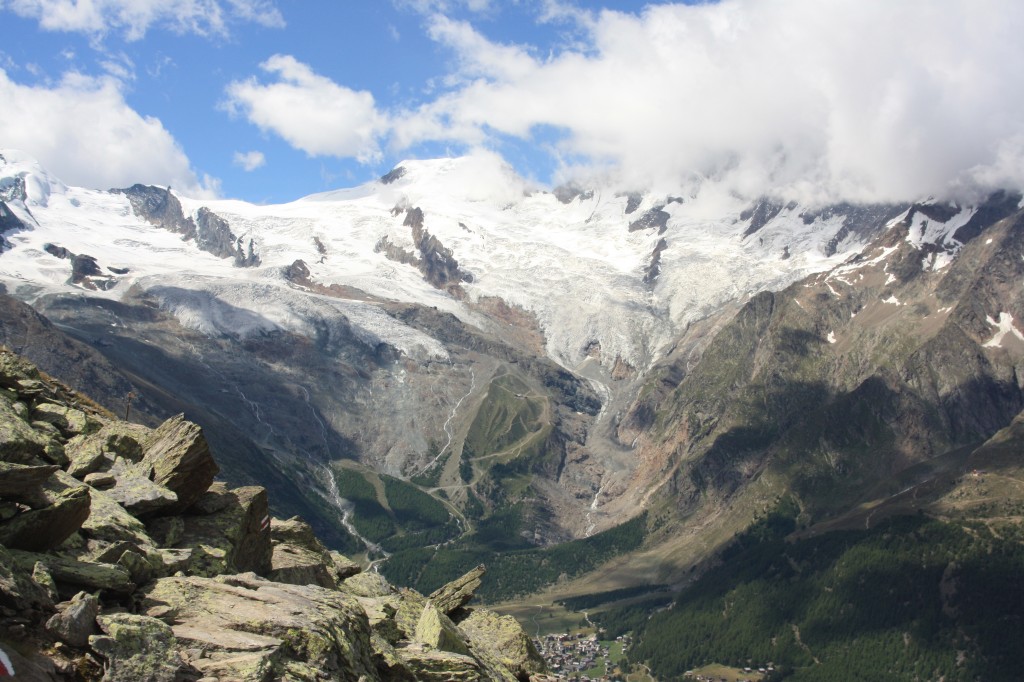
Alpine glacier like these in Saas-Fee, Switzerland, have declined dramatically in recent decades. (I.Quaile)
Radford also refers to ascertaining the melting of alpine glaciers by comparing historic paintings and other documentation with the current ice mass. That decline is something I have observed at first hand in Valais in Switzerland during regular visits over the past 30 years. Look out for a comparative photo gallery of my own pics, when I get time to put it together. Since most of the shots are from the pre-digital era, that will be a time-consuming task.
I also remember a trip to the Visitor Centre of the Begich Boggs glacier in Alaska in 2008. The glacier has already retreated so far you can’t see it at all from the Centre built specially for the purpose of viewing it.
The question until now was how much of all this was caused by natural developments and how much to changes in land use and the emission of greenhouse gases? The latest study supported, among others, by the Austrian Science Fund (FWF) and the research area Scientific Computing at the University of Innsbruck, has come up with some answers. Since the climate researchers were able to include different factors contributing to climate change in their model, they can differentiate between natural and anthropogenic influences on glacier mass loss
“While we keep factors such as solar variability and volcanic eruptions unchanged, we are able to modify land use changes and greenhouse gas emissions in our models,” says Ben Marzeion, who sums up the study: “In our data we find unambiguous evidence of anthropogenic contribution to glacier mass loss.”
As always, there is still need for further research – and a lot more monitoring. The scientists say the current observation data is insufficient in general to derive any clear results for specific regions, even though anthropogenic influence is detectable in a few regions such as North America and the Alps, where glaciers changes are particularly well documented.
With global glacier retreat contributing to rising sea-levels, changing seasonal water availability and increasing geo-hazards, the study’s conclusions should help put a little more pressure on the world’s decision-makers to get serious about emissions reductions.
Arctic methane: time bomb or “boogeyman”?
When the Ice Blog was launched in 2008, one of the first posts from a trip to Alaska entitled “Ice-Capades and Alaska baking with methane?” included a visit to frozen-over “Eight-mile Lake” in the Denali national park, where scientists Katey Walter and Laura Brosius were measuring methane emissions from melting ice and permafrost. The young “climate ambassadors” I was travelling with helped her to set up “umbrella traps” and capture bubbles of methane coming to the surface. The “proof of the pudding” was setting a match to the gas and watching it catch light. An interesting experiment. But the subject has huge wide-ranging implications. Methane is also a greenhouse gas 25 times more powerful than CO2. Walter and others have since recorded numerous methane seeps in Alaska and Greenland. As global temperatures increase, the permafrost thaws, potentially releasing the gas stored both in the permafrost on land and in the form of methane hydrates under water.
Since that Alaskan trip, methane has beconme an increasingly “hot topic”, with more research being conducted and data collected. The reservoir of methane stored under the Arctic ice and permafrost is huge. And there is increasing scientific evidence that with the world warming, this reservoir is not going to stay there for ever. The concentration of atmospheric methane has increased dramatically in the last 200 years – especially in the Arctic. In 2008, scientists came up with a scenario where up to 50 gigatonnes of methane could be released abruptly from the East Siberia Arctic Shelf (ESAS) because of the melting of permafrost which had hitherto kept it safely sealed in.
Fountains of methane
In 2011, a joint US-Russian expedition surveying the seabed of the East Siberian Arctic Shelf off northern Russia was surprised to observe fountains of methane rising to the sea surface from beneath the seabed. At that time, scientists expressed concern that with the melting of Arctic sea ice and permafrost, the huge methane stores might be released over a relatively short period of time.
The SWERUS-C3 expedition headed by Örjan Gustafsson from Stockholm University is currently underway in the Laptev Sea, where they have discovered “vast methane plumes escaping from the seafloor of the Laptev continental slope”. Gustavsson writes in his blog that he was surprised by this. He speculates that it could have its origins in collapsing “methane hydrates”, clusters of methane trapped in frozen water due to high pressure and low temperatures.
“While there has been much speculation about the vulnerability of regular marine hydrates along the continental slopes of the Arctic rim, very few actual observations of methane releases due to collapsing marine hydrates on the Arctic slope have been made”, Gustafsson writes. He thinks a “tongue” of relatively warm Atlantic water, presumably intruding across the Arctic Ocean at 200-600 meters depth could have something to do with the methane seeps. Some evidence shows this water mass has recently become warmer.
“As this warm Atlantic water, the last remnants of the Gulf stream, propagates eastward along the upper slope of the East Siberian margin, it may lead to the destabilization of methane hydrates on the upper portion of the slope”, Gustafsson writes.
Costly bubbles
In 2013, a paper published in the journal Nature put a price tag on the possibility of the Arctic’s methane being released. The experts suggest it could trigger costs of 60 trillion US dollars. Normally, as soon as money is involved, public interest tends to rise. The report should really have brought the subject of “Arctic methane hydrates” out of the science corner onto the economic and political agenda. Which is, of course, where it has to be, if there is any chance of limiting the Arctic thaw by halting global warming.
There are scientists who insist that such a scenario is not likely. Let me refer you here to a detailed analysis of the scientific literature on the subject published by Nafeez Ahmed, executive director of the Institute for Policy Research & Development, in EarthInsight hosted by the Guardian, in 2013. He points out that none of the scientists who reject the plausibility of the scenario are experts in the Arctic, and specifically the ESAS. On the other hand, there is an emerging consensus among ESAS specialists based on continuing fieldwork, he writes, “highlighting a real danger of unprecedented quantities of methane venting due to thawing permafrost”.
Rhetoric, polemics – but accuracy please!
Ahmed comes down on the side of the Arctic experts who are highly concerned about the risk of methane being set free in large quantities. That is already clear from the title of his article “Seven facts you need to know about the Arctic methane timebomb”. Sub-headed: “Dismissals of catastrophic methane danger ignore robust science in favour of outdated mythology of climate safety.” Yes, you could say that is tendentious. It is certainly rhetorically powerful.
Perhaps that accounts in part for the reaction I got when I tweeted the link to his analysis recently as interesting background to the ongoing debate on Arctic methane. One response told me to stop “fear mongering” and referred to an article describing methane as a “climate boogeyman”. (In connection with studies on methane leaks from natural gas production). Aha. Emotions are running high – on both sides.
Still – Ahmed’s article is based on a thorough analysis of both sides of the arguments. It seems this cannot be said of a piece on news.com.au, headlined “Are Siberia’s methane blow-holes the first warning sign of unstoppable climate change?”. The article links three giant craters which have been found in Siberia to the scientific research of Jason Box, a renowned glaciology professor and Greenland expert, starting with the tantalizing question:
“What do three enormous craters in the Siberian wastelands have to do with a terrified American climate scientist? Methane. And that’s something to scare us all”.
In fact, as Jason Box @climate_ice tweeted to his followers, the Arctic expert’s research and concern have nothing to do with the giant craters. He tweets:
“News piece juxtaposes Siberian holes with my carbon release concerns but I have no idea about the holes”
Citing the concerns and findings of reputed scientists alongside other reported explanations of the Siberian craters as “hellmouths”, “gateways to the undead” or “aliens” does nothing for serious scientific attempts to monitor climate change in the Arctic or inform politicians and businesses about the scenarios for which the world has to prepare. Now if those of a skeptical persuasion were to take this kind of article as “fear mongering” or the “climate boogeyman”, I could just about understand it. Please, let us not detract from the value of scientific monitoring and analysis, complex computer modeling and genuine concern on the part of a lot of experts who know very well what they are talking about. And let us not bring the media into disrepute for misrepresenting the views of scientists like Jason Box by taking his findings and statements out of context in the interest of a sensationalist story. We do not need to mix fact with fiction and create “boogeymen”. The huge body of scientific findings out there is already scary enough.
Arctic thaw – carry on regardless?
When a colleague who has a lot of sympathy for those who do NOT accept that humans are responsible for global warming drew attention to the fact that this had been the hottest June on record, following hard on the hottest May, I must admit I was temporarily put of my guard. Aha, I thought. Is he finally getting the message? Alas, the answer is no. There is a small minority of people that still argues – for whatever reason – that natural variation could be responsible for all this, while acknowledging the record concentration of CO2 in the atmosphere. “And all that stuff”. Hm.
![]() read more
read more



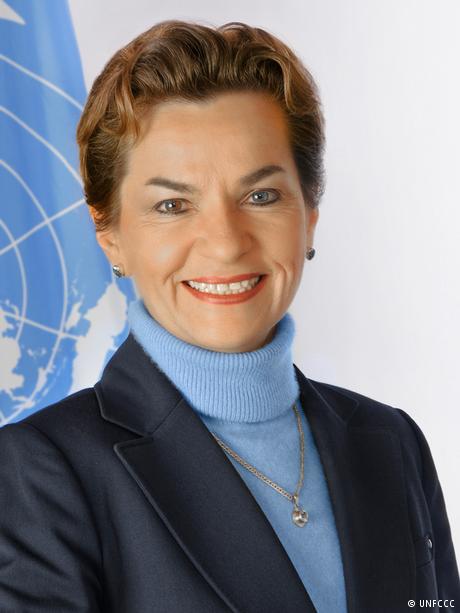

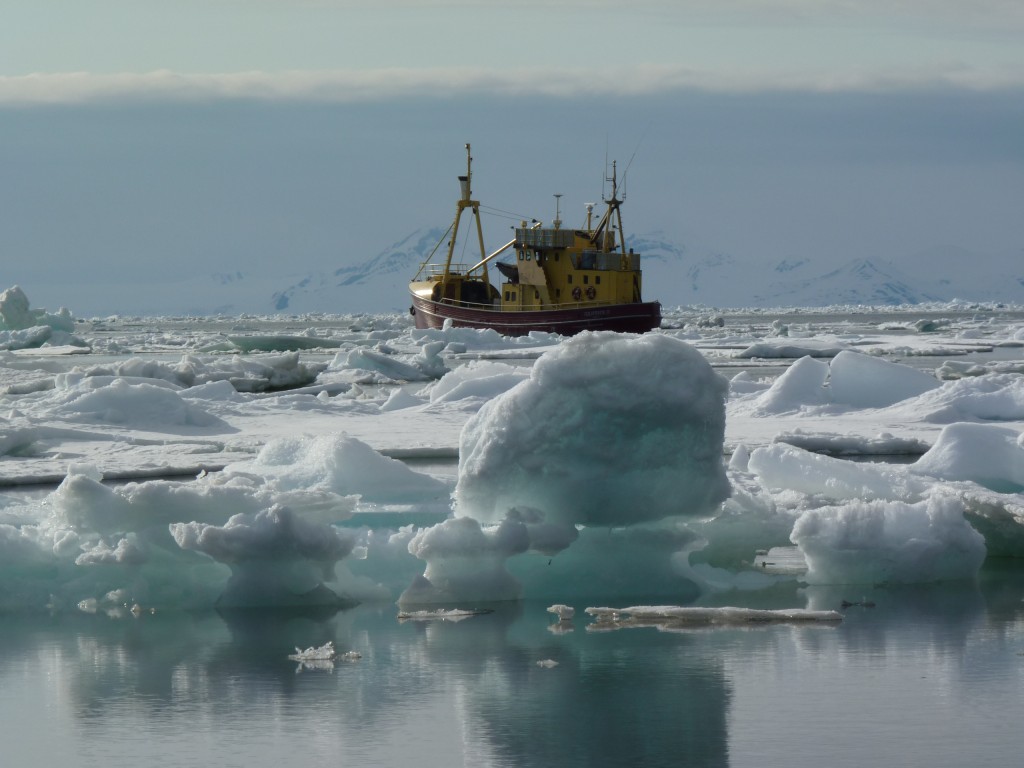
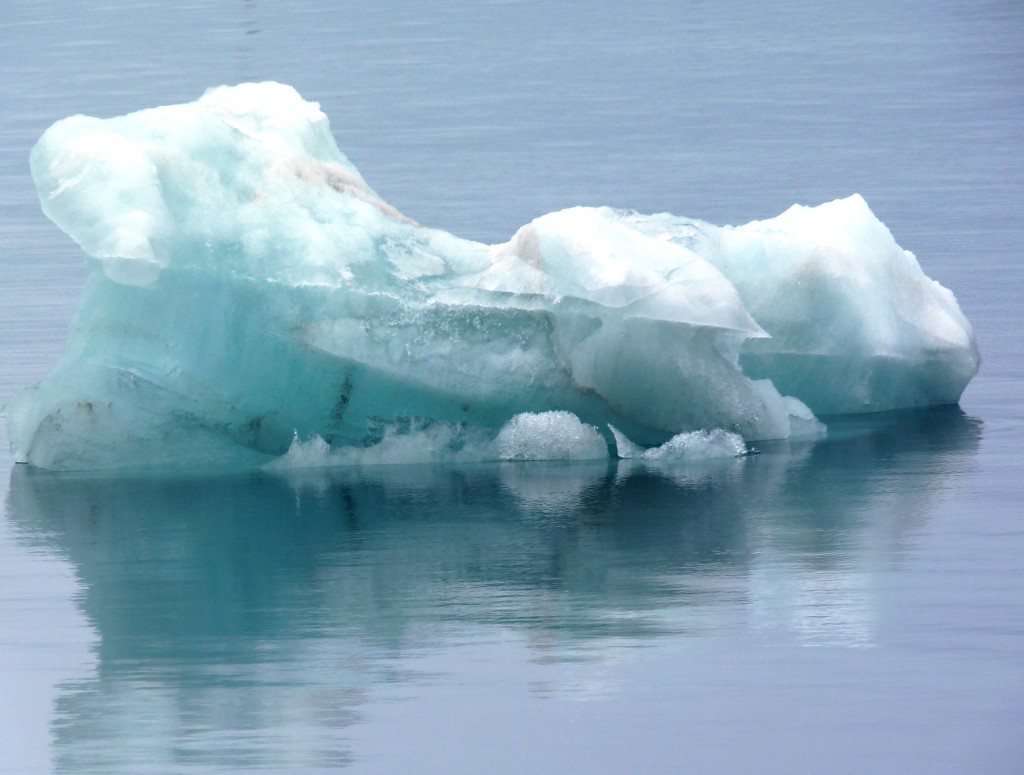
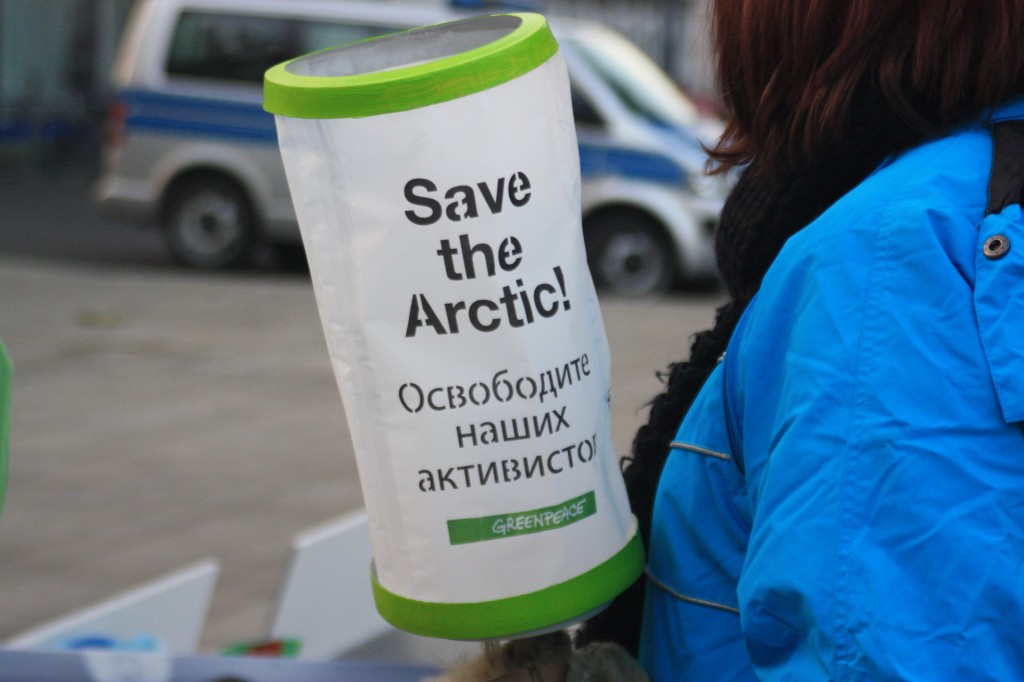
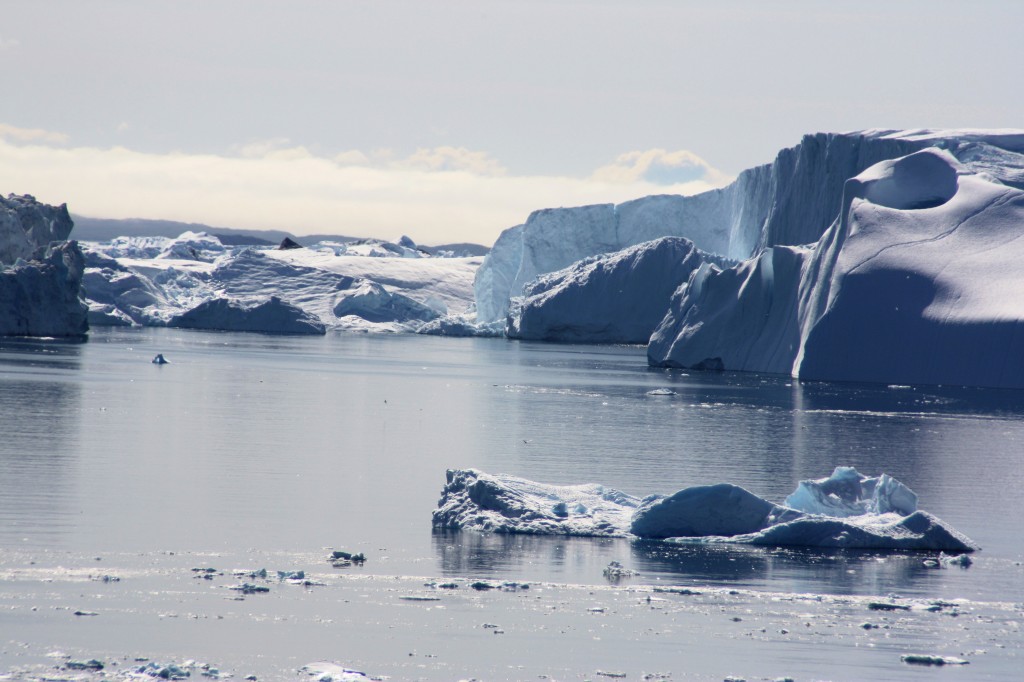
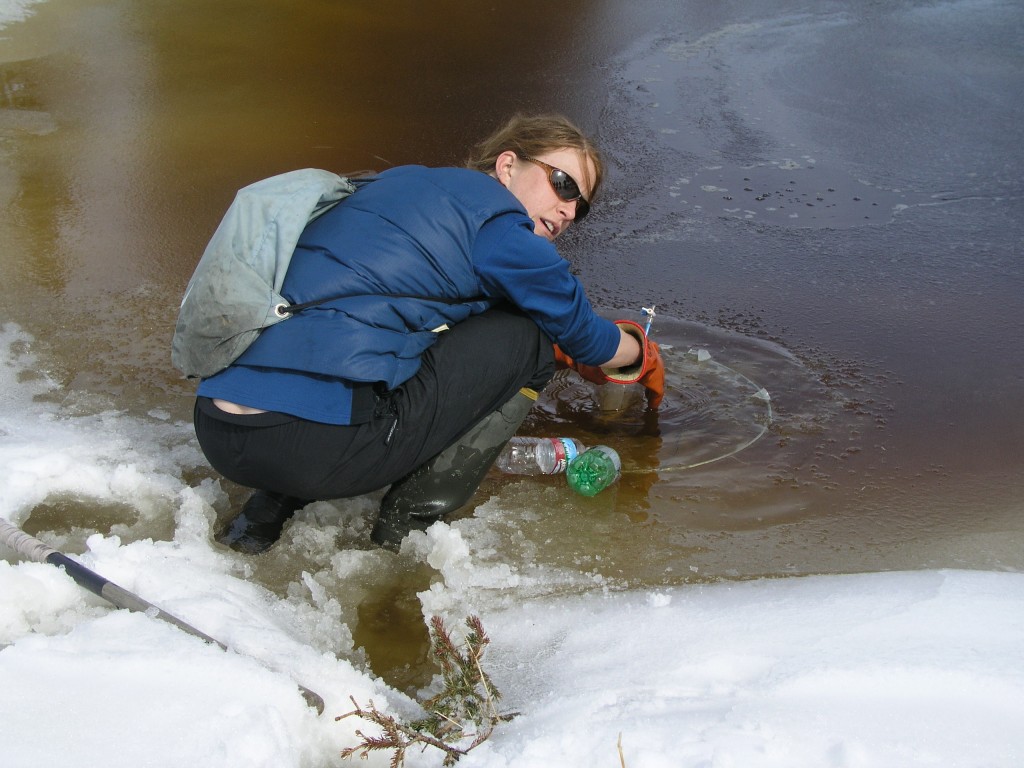
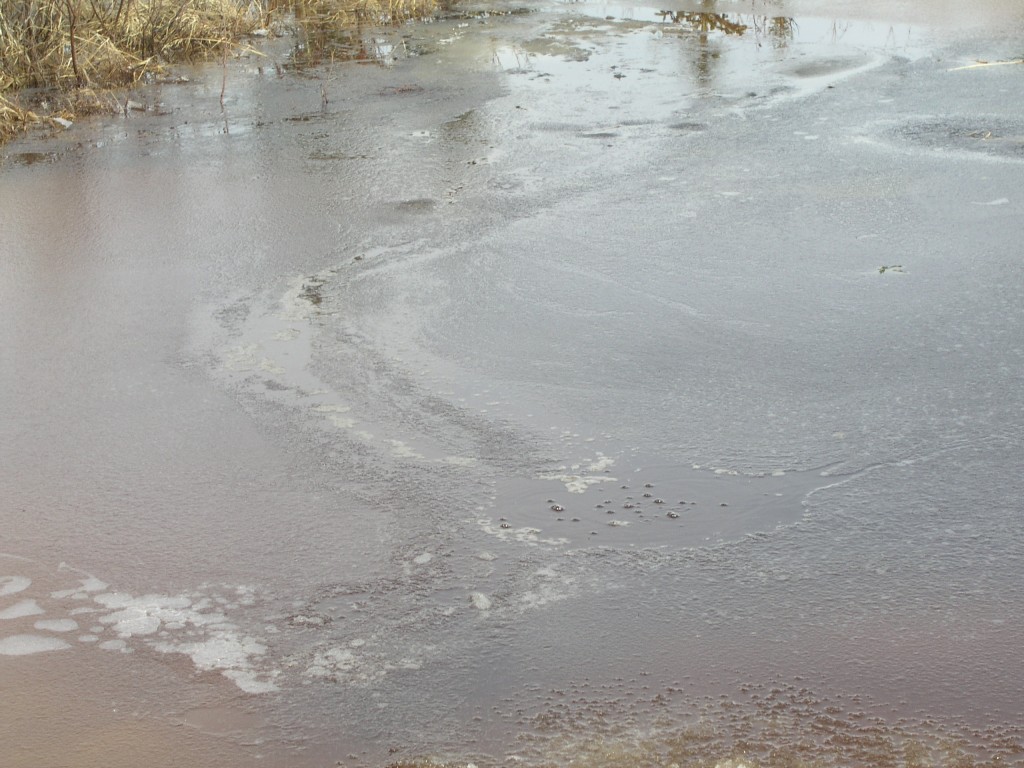
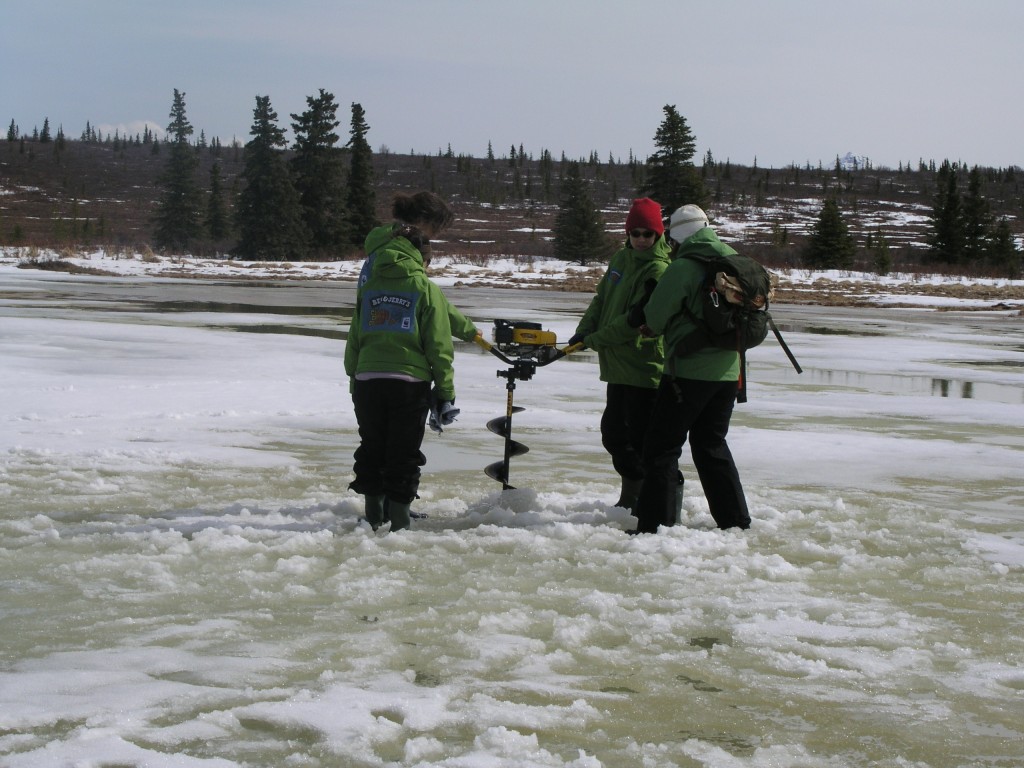
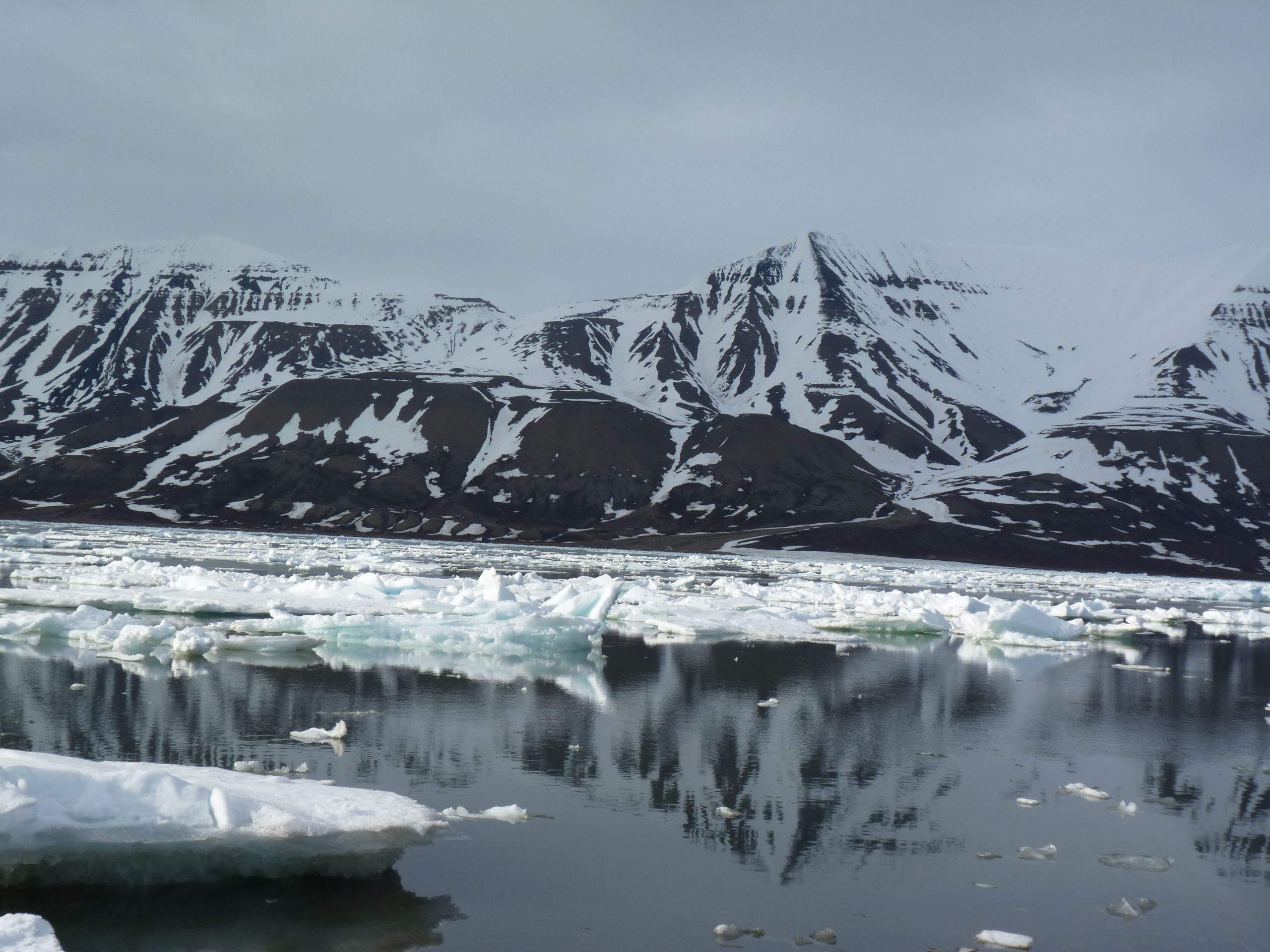
















Feedback